CONCEPT25.1 Plants Acquire Mineral Nutrients from the Soil
Like all organisms, plants are made up primarily of water and molecules that contain the major elements of life. Nearly all plants are autotrophs that obtain carbon from atmospheric carbon dioxide through the carbon-fixation reactions of photosynthesis. They obtain carbon, hydrogen, and oxygen from air and water, so these elements are plentiful as long as plants have an adequate water supply.
The plant body contains other elements as well. Nitrogen, for example, is essential for the synthesis of proteins and nucleic acids. Plants obtain nitrogen, directly or indirectly, through the activities of bacteria and fungi, as we will see later in this chapter. In addition, proteins contain sulfur (S), nucleic acids contain phosphorus (P), and chlorophyll contains magnesium (Mg). Metal ions also play important biochemical roles in plants. For example, Fe2+ is used as a cofactor in electron transport in mitochondria and chloroplasts. Plants obtain these and other mineral nutrients mainly from the soil. Mineral nutrients dissolve in water in the soil as ions, forming a solution—called the soil solution—that surrounds the roots of plants.
LINK
The major elements of life are described in Chapter 2, and the chemical reactions of photosynthesis in Concepts 6.5 and 6.6
Nutrients can be defined by their deficiency
A plant nutrient is called an essential element if its absence causes severe disruption of normal plant growth and reproduction. An essential element cannot be replaced by any other element. There are two categories of essential elements:
- Macronutrients have concentrations of at least 1 gram per kilogram of the plant’s dry matter. There are six macronutrients:
Nitrogen (taken up as NO3− or NH4+)
Phosphorus (taken up as PO43−)
Potassium (taken up as K+)
Sulfur (taken up as SO42−)
Calcium (taken up as Ca2+)
Magnesium (taken up as Mg2+)
- Micronutrients have concentrations of less than 0.1g/kg of the plant’s dry matter. They include iron (Fe2+), chlorine (Cl−), manganese (Mn2+), zinc (Zn2+), copper (Cu2+), nickel (Ni2+), boron (BO3−3), and molybdenum [Mo(O4)2−].
Plants show characteristic symptoms, most noticeable in leaves, that can be used to diagnose deficiencies of essential elements (FIGURE 25.1). With proper diagnosis, the missing nutrient(s) can be provided in the form of a supplement, or fertilizer.
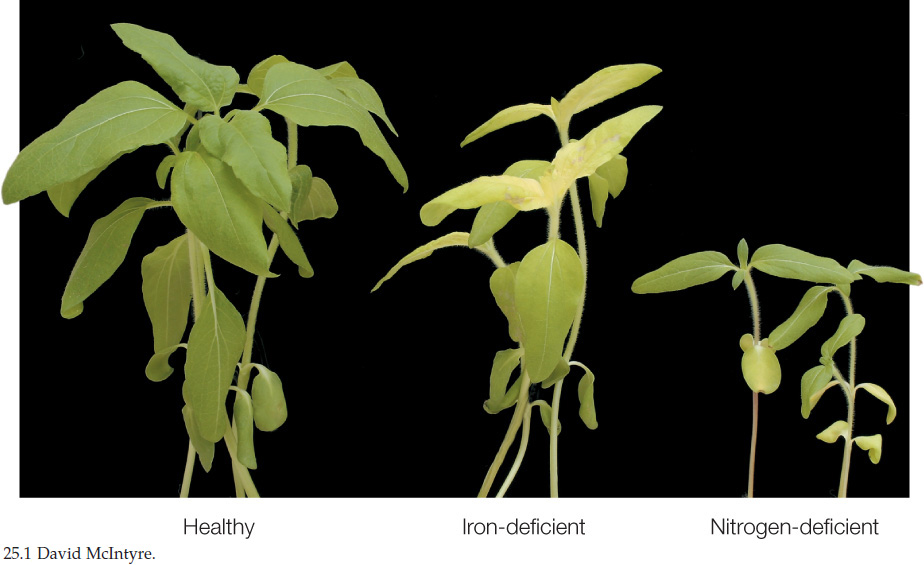
Experiments using hydroponics have identified essential elements
The essential elements for plants were largely identified by growing plants hydroponically—that is, with their roots suspended in nutrient solutions instead of soil:
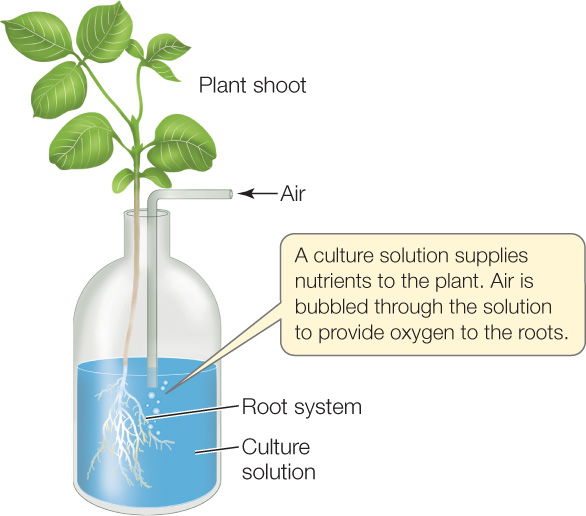
Growing plants in this manner allows for greater control of nutrient availability than is possible in a complex medium like soil.
In the first successful experiments of this type, performed a century and a half ago, plants grew seemingly normally in solutions containing only calcium nitrate [Ca(NO3)2], magnesium sulfate (MgSO4), and potassium phosphate (KH2PO4).
539
A solution missing any of these compounds could not support normal plant growth. Tests with other compounds that included various combinations of these same elements soon established the six macronutrients listed above.
Identifying micronutrients by this experimental approach proved to be more difficult because of the small amounts involved. Sufficient amounts of a micronutrient can be present as contaminants in the environment used to grow plants. Therefore nutrition experiments must be performed in tightly controlled laboratories with special air filters that exclude microscopic mineral particles, and they must use only the purest available chemicals. Furthermore, a seed may contain enough of a micronutrient to supply the embryo and the resultant second-generation plant throughout its lifetime. There might even be enough left over to pass on to the next generation of plants. Thus even if a plant is completely deprived of a micronutrient, it may take a long time for deficiency symptoms to appear. The most recent micronutrient to be listed as essential was nickel, in 1983 (FIGURE 25.2).
Investigation
HYPOTHESIS
Nickel is an essential element for plants.
- Grow barley plants for three generations in hydroponic solutions containing 0, 0.6, and 1.0 μM nickel sulfate (NiSO4).
- Harvest seeds from 5 or 6 third-generation plants in each of the groups.
- Determine the nickel concentration in some of the seeds from each plant.
- Germinate the other seeds from the same plants in a nickel-free hydroponic solution and plot the success of germination against nickel concentration.
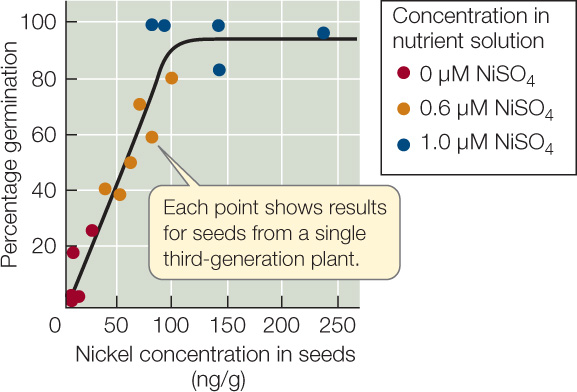
There was a positive correlation between seed germination and nickel concentration. There was significantly less germination at the lowest nickel concentrations.
CONCLUSION
Barley seeds require nickel in order to germinate and complete their life cycle.
ANALYZE THE DATA
- What do the blue points have in common? Why are there five blue points instead of just one?
- What is the biological meaning of the zero/zero point?
- Why didn’t the investigators examine only the plants grown without nickel in their hydroponic solution?
- Plant biologists define the critical value for a mineral nutrient as that concentration in plant tissue that results in a 15 percent reduction in the optimal yield of the plant. Using maximum germination percentage in this experiment as the optimal yield, estimate the critical value for nickel.
Go to LaunchPad for discussion and relevant links for all INVESTIGATION figures.
aP. H. Brown et al. 1987. Plant Physiology 85: 801–803.
Soil provides nutrients for plants
Most terrestrial plants grow in soil, which provides plants with a number of benefits:
- Anchorage for mechanical support of the shoot
- Mineral nutrients and water from the soil solution
- O2 for root respiration in root tissues from air spaces between soil particles
- The services of other soil organisms
Soils have both living and nonliving components. The living components include plant roots as well as populations of bacteria, fungi, protists, and animals such as earthworms and insects. The nonliving portions of the soil include rock fragments ranging in size from large stones to clay particles 2 μm or less in diameter. Soil also contains water and dissolved mineral nutrients, air spaces, and dead organic matter:
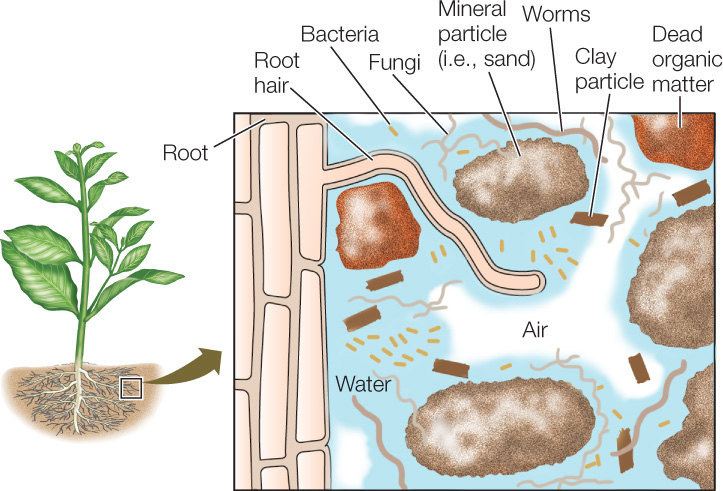
540
Although soils vary greatly, almost all of them have a soil profile consisting of several horizontal layers, called horizons. Soil scientists recognize three major horizons—termed A, B, and C—in a typical soil (FIGURE 25.3):
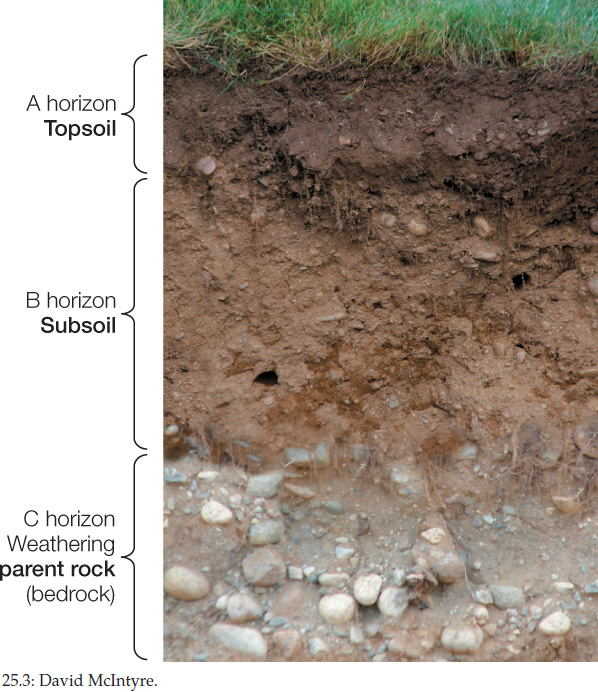
- The A horizon is the topsoil that supports the plant’s mineral nutrient needs. It contains most of the soil’s living and dead organic matter.
- The B horizon is the subsoil, which accumulates materials from the topsoil above it and the parent rock below.
- The C horizon is the parent rock from which the soil arises.
Parent rock is broken down into soil particles (weathered) in two ways:
- Mechanical weathering is the physical breakdown of materials by wetting, drying, and freezing.
- Chemical weathering is the alteration of the chemistry of the materials in the rocks by oxidation, water, and acids.
The soil’s fertility (its ability to support plant growth) is determined by several factors. The size of the soil particles in the A horizon, for example, is important in determining nutrient retention and other soil characteristics. Mineral nutrients in the soil solution can be leached (washed away) from the A horizon downward by rain (or irrigation) and thereby become unavailable to plants. Tiny clay particles bind a lot of water, and mineral nutrients are not readily leached from them, but clay particles pack tightly and leave little room for air. Large sand particles have opposite properties; they provide plenty of air spaces but do not retain water or nutrients. A loam is a soil that is an optimal mixture of sand, clay, and silt (mineral particles intermediate in size between sand and clay) and thus has sufficient supplies of air, water, and nutrients for plants.
In addition to mineral particles, soils contain dead organic matter, largely from plants. Soil organisms break down dead leaves and other organic materials that fall to the ground into a substance called humus. This material is used as a food source by microbes that break down complex organic molecules and release simpler molecules into the soil solution. Humus also improves the texture of soil and provides air spaces that increase oxygen availability to plant roots.
Ion exchange makes nutrients available to plants
Chemical weathering results in clay particles covered with negatively charged chemical groups (FIGURE 25.4). These negatively charged clay particles bind the positively charged ions (cations) of minerals that are important for plant nutrition, such as potassium (K+), magnesium (Mg2+), and calcium (Ca2+). This binding prevents the cations from being leached out of the soil, but to become available to plants, they must be released from the clay particles into the soil solution.
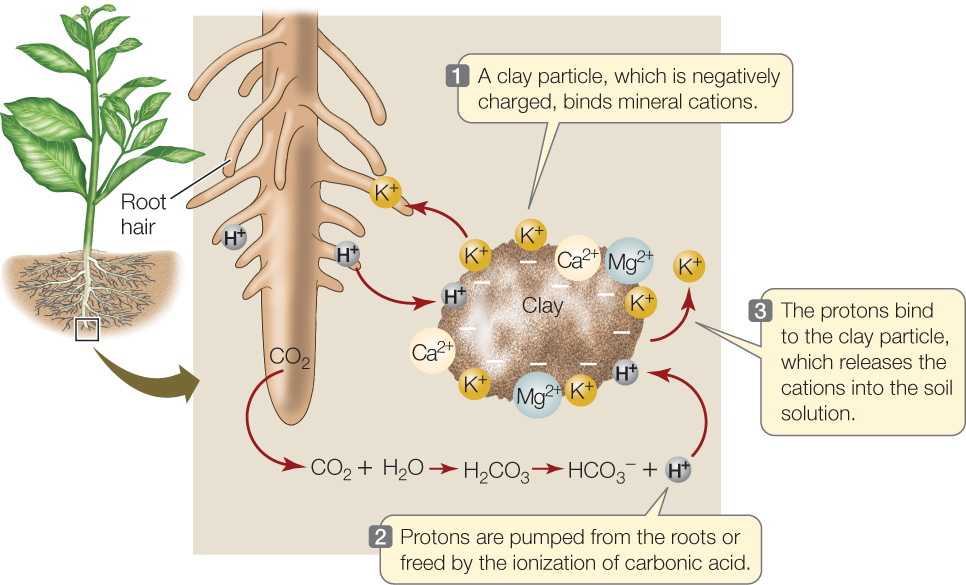
Recall that the root surface is covered with epidermal cells bearing root hairs (see Figure 24.8C). Proteins in the cell membrane of these cells actively pump protons (H+) out of the cells, as we’ll describe in Concept 25.3. In addition, cellular respiration in the roots releases CO2, which dissolves in the soil water and reacts with it to form carbonic acid. This acid ionizes to form bicarbonate and free protons:
CO2 + H2O ⇌ H2CO3 ⇌ H+ + HCO3−
Proton pumping by the root cells and ionization of carbonic acid both act to increase the proton concentration in the soil surrounding the root. The protons bind more strongly to clay particles than do mineral cations; in essence, the protons trade places with the cations in a process called ion exchange (see Figure 25.4). Ion exchange releases mineral nutrient cations into the soil solution, where they are available to be taken up by roots. Soil fertility is determined in part by the soil’s ability to provide nutrients in this manner.
541
There is no comparable mechanism for binding and releasing negatively charged ions. As a result, important anions such as nitrate (NO3−) and sulfate (SO42−) may be leached from the A horizon.
Fertilizers can be used to add nutrients to soil
Leaching and the harvesting of crops may deplete a soil of its nutrients, in which case the growth of subsequent crops on that soil will be reduced. Three ways to restore the nutrient content of soils are shifting agriculture, organic fertilizers, and inorganic (chemical) fertilizers.
Shifting Agriculture
In the past, when the soil could no longer support a level of plant growth sufficient for agricultural purposes, people simply moved to another location. This nomadic existence allowed the soil to replenish its nutrients naturally, by weathering of the parent rock and gradual accumulation and breakdown of organic matter. These processes take a long time, but that was not a problem as long as a lot of land was available. After many years in other locations, the people could return to their original land, which was again able to support farming. Today the food needs of a large human population are too great to allow land to be left unfarmed for a long time; in addition, most people live more settled lives now and do not want to move.
Organic Fertilizers
Humus is used as a food source by soil organisms, which in turn release simpler molecules to the soil solution. For example:

These simpler molecules can dissolve in soil water and be taken up by plant roots.
Farmers can increase the nutrient content of soil by adding organic materials such as compost (partially decomposed plant material) or manure (the waste from farm animals), which is a particularly good source of nitrogen. In either case, these organic fertilizers add nutrients to the soil much more rapidly than natural processes, but still allow for a slow release of ions, with little leaching, as the materials decompose.
Inorganic Fertilizers
Because organic fertilizers may still act too slowly to restore fertility if a soil is to be farmed every year, inorganic fertilizers are used to supply mineral nutrients directly in forms that can be immediately taken up by plants. Inorganic fertilizers are characterized by their “N-P-K” percentages. A 5-10-10 fertilizer, for example, contains 5 percent nitrogen (as NH4+), 10 percent phosphate (P2O5), and 10 percent potash (K2O) by weight (of the nutrient-containing compound, not as weights of the elements N, P, and K). Sulfur, in the form of ammonium sulfate [(NH4)2SO4], is also occasionally added to soils.
To return to our example of nitrogen, inorganic fertilizers reach plants by this process:

The manufacture of nitrogen fertilizer begins with an energyintensive industrial process in which N2 is combined with H2 at high temperatures and pressures in the presence of a catalyst to form ammonia (NH3). This process accounts for about 2 percent of the world’s energy use, mostly in the form of natural gas. Although organic and inorganic fertilizers have the same effects on crop nutrition, their costs are very different: manure and compost are free, whereas NH4+ made in a factory can be very expensive.
LINK
The cycling of nitrogen through biological systems is described in Chapter 45, and some of the prokaryotes that participate in that cycling are described in Concept 19.3
CHECKpointCONCEPT25.1
- What are the differences between:
- macronutrients and micronutrients?
- organic and inorganic fertilizers?
- the availability to plant roots of a cation and an anion?
- Outline an experimental method for determining whether an element is essential to a plant.
- A label on a bin in a market states “Organic apples, grown without chemical fertilizers.” Are these apples different in terms of plant molecules than they would be if they were grown with chemical fertilizers?
We have just described some of the physical and chemical aspects of soils that are vital to plant nutrition. But many other organisms besides plants inhabit soils. We will turn now to the effects of those organisms on plants.